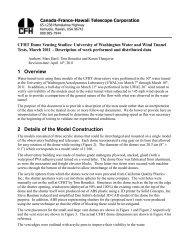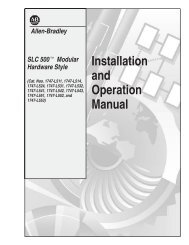Documentation [PDF] - Canada France Hawaii Telescope ...
Documentation [PDF] - Canada France Hawaii Telescope ...
Documentation [PDF] - Canada France Hawaii Telescope ...
Create successful ePaper yourself
Turn your PDF publications into a flip-book with our unique Google optimized e-Paper software.
Figure 12: PSF model for the four quadrants of the CFHTLS-Wide stack CFHTLS_W_z_222054-003100_T0007.<br />
The circles represent the apertures used for the SNLS and IQ20 magnitudes.<br />
the PSF variations across a quarter of a MEGACam field of view, a single PSF model is computed : this<br />
approximation is motivated by the small variation of the PSF shape and size across the MegaCam field<br />
of view compared to the (much larger) variations between the L99 images and the stacks.<br />
The CFHTLS T0007 catalogues offer the MAG_SNLS magnitude since it is the measured value for each<br />
source on the image, but it is the aperture corrected magnitude based on the four PSF models for each<br />
stacks (and the corresponding four aperture corrections - ApCorr), MAG_IQ20, that ought to be used for<br />
any calibration or scientific purposes on point sources.<br />
MAG_IQ20 = MAG_SNLS + ApCorr (3)<br />
3.7.4 Quantifying the improvements using MAG_IQ20 compared to MAG_SNLS<br />
Deep fields observations bracket L99 observations. Since L99 observations were taken in photometric<br />
conditions, the zero-points derived from the comparison of the instrumental magnitudes and the SNLS<br />
tertiary standards catalogues should not change. By comparing the zero-points in these pairs of Deep<br />
observations (before and after L99 observations) in Table 1, on can see that the MAG_IQ20 is a more<br />
stable estimator than MAG_SNLS. stability improves even for Deep images with identical seeing. This<br />
result indicates that the scatter in the aperture correction at a given seeing seen in Figure 10 captures real<br />
information on the varying PSF shape of identical size.<br />
In conclusion, the variation of the aperture correction with the seeing shown in Figure 10 provides indication<br />
that the SNLS flux is not a truly valid proxy of the total flux (measured by the IQ20 aperture<br />
photometry) when the images have a large spread in image quality. Our current approach circumvent this<br />
17


![Documentation [PDF] - Canada France Hawaii Telescope ...](https://img.yumpu.com/26965302/29/500x640/documentation-pdf-canada-france-hawaii-telescope-.jpg)









